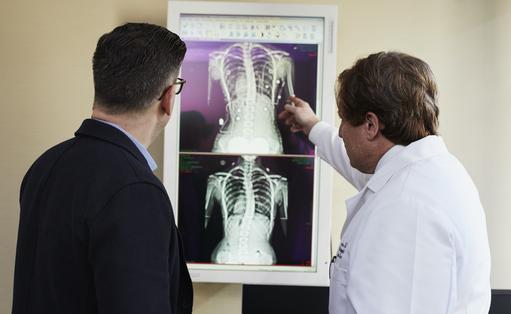Tag
Tagged: lumbar spinal fusion
Directory:
Tags:

|
|
|
Directory:
Tags:

- In high-income countries populations are aging
- By 2050 the world population of people over 60 is projected to reach 2bn
- Age-related low back pain is the highest contributor to disability in the world
- Over 80% of people will experience back pain at some point in their life
- Older people with back pain have a higher chance of dying prematurely
- The causes of back pain are difficult to determine which presents challenges for the diagnosis and management of the condition
- The US $100bn-a-year American back pain industry is “ineffective”
- Each year 10,000 and 300,000 spine fusion surgeries are carried out in the UK and US respectively
- 20% of spinal fusion surgeries are undertaken without good evidence
- In 10 to 39% of spine surgery patients pain continues or worsens after surgeries
Age of the aged and low back pain
A triumph of 20th century medicine is that it has created the “age of the aged”. By 2050 the world population of people aged 60 and older is projected to be 2bn, up from 900m in 2015. Today, there are 125m people aged 80 and older and by 2050 there is expected to be 434m people in this age group worldwide. The average age of the UK population has reached 40. Some 22% will be over 65 by 2031, and this will exceed the percentage of the UK population under 25. 33% of people born today in the UK can expect to live to 100. However, this medical success is the source of rapidly increasing age-related disorders, which present significant challenges for the UK and other high-income nations. Low back pain (LBP) is the most common age-related pain disorder, and ranked as the highest contributor to disability in the world.
At some point back pain affects 84% of all adults in developed economies. Research published in 2017 in the journal Scoliosis Spinal Disorders suggests that LBP is the most common health problem among older adults that results in pain and disability. The over 65s are the second most common age group to seek medical advice for LBP, which represents a significant and increasing workload for health providers. Each year back pain costs the UK and US Exchequers respectively some £5bn and more than US635bn in medical treatment and lost productivity. LBP accounts for 11% of the total disability of the respective populations. This Commentary discusses therapies for LBP, and describes the changing management landscape for this vast and rapidly growing condition.
Your spine and LBP
Your spine, which supports your back, consists of 24 vertebrae, bones stacked on top of one another. At the bottom of your spine and below your vertebrae are the bones of your sacrum and coccyx. Threading through the entire length of your vertebrae is your spinal cord, which transmits signals from your brain to the rest of your body. Your spinal cord ends in your lower back, and continues as a series of nerves, which resemble a horse’s tail, hence its medical name, ‘cauda equine’. Between each vertebra are discs. In younger people discs contain a high degree of water. This gives them the ability to act like shock absorbers. During the normal aging process discs lose much of their water content and degenerate. Such degenerative spinal structures may result in a herniated disc when the disc nucleus extrudes through the disc’s outer fibres, or a compression of nerve roots, which may lead to radiculopathy. This is a condition more commonly known as sciatica, which is pain caused by compression of a spinal nerve root in the lower back that is often associated with the degeneration of an intervertebral disc, and can manifest itself as pain, numbness, or weakness of the buttock and outer side of the leg.
Challenges in diagnosis
Because your back is comprised of so many connected tissues, which include bones, muscles, ligaments, nerves, tendons, and joints, it is often difficult for doctors to say with confidence what causes back pain even with the help of X-rays and MRI scans. Usually, LBP does not have a serious cause. In the majority of cases LBP will reduce and often disappear within 4 to 6 weeks, and therefore can be self-managed by keeping mobile and taking over-the-counter painkillers. However, in a relatively small proportion of people with LBP, the pain and disability can persist for many months or even years. Once LBP has been present for more than a year few people return to normal activities. There is not sufficient evidence to suggest definitive management pathways for this group that accounts for the majority of the health and social costs associated with LBP.
Assessing treatment options for back pain
Ranjeev Bhangoo, a consultant neurosurgeon at Kings’ College Hospital Trust, London, and the London Neurosurgery Partnership describes the nature and role of intervertebral discs and how treatment options should be assessed.
“When a person presents with a problem in the lower back, which might manifest as leg or arm pain, you need to ask 3 questions: (i) is the history of the pain compatible with a particular disc causing the problem? (ii) Does an examination suggest that a particular disc is causing a problem? And (iii) does a scan show that the disc you thought was the problem is the problem? If all 3 answers align, then there maybe some good reason to consider treatment options. If the 3 answers are not aligned, be weary of a surgeon suggesting intervention because 90% of us will experience back pain at some point in our lives, and 90% of the population don’t need back surgery.”
Back pain requiring immediate medical attention
Although the majority of LBP tends to be benign and temporary, people should seek immediate medical advice if their back pain is associated with certain red flags such as loss of bladder control; loss of weight, fever, upper back or chest pain; or if there is no obvious cause for the pain; or if the pain is accompanied by weakness, loss of sensation or persistent pins and needles in the lower limbs. Also, people with chronic lifetime conditions such as cancer should pay particular attention to back pain.
Epidemiology of LBP
Back pain affects approximately 700m people worldwide. A 2011 report by the US Institute of Medicine, estimates that 100m Americans are living with chronic back pain, which is more than the total affected by heart disease, cancer, and diabetes combined. This represents a vast market for therapies that include surgery and the prescription of opioids. Estimates of the prevalence of LBP vary significantly between studies. There is no convincing evidence that age affects the prevalence of back pain, and published data do not distinguish between LBP that persists for more than, or less than, a year. Each year LBP affects some 33% of UK adults, and around 20% of these - about 2.8m - will consult their GP. One year after a first episode of back pain, 62% of people still experience pain, and 16% of those initially unable to work are not working after 1 year. Typically in about 60% of cases pain and disability improve rapidly during the first month after onset.
|
|







